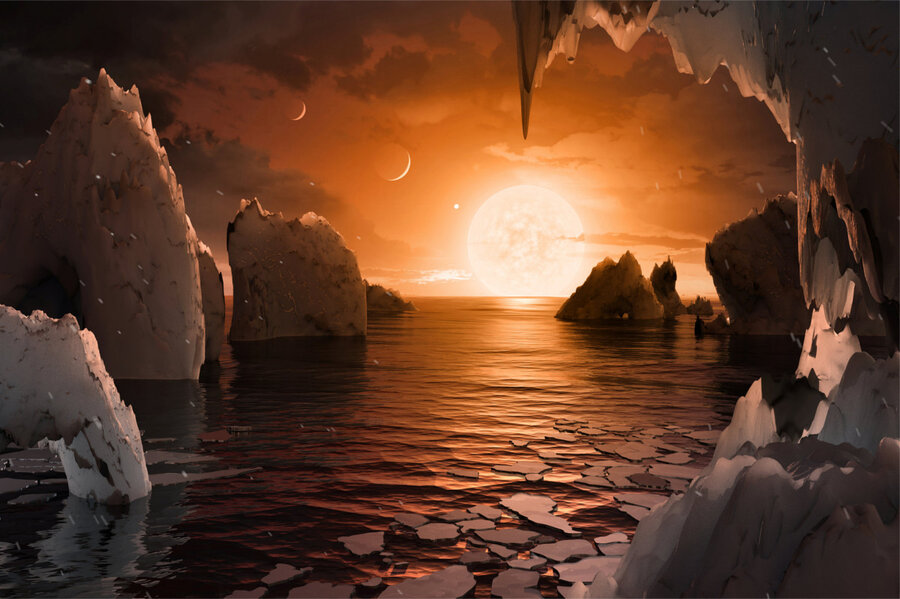Could the TRAPPIST-1 exoplanets harbor alien life?
Loading...
If the sun never set, could life evolve?
Last week, astronomers announced that they had found a miniature solar system with seven Earth-sized planets in tiny, fast orbits around the super-cool dwarf star TRAPPIST-1.
Some, and perhaps all, of the seven planets are "tidally locked" to their dwarf star, say the researchers, which means the same side of each planet always faces the star. One side is always in daylight, and one side is always dark.
That's not a deal-breaker for life, the team said during an "Ask Me Anything" question and answer session on Reddit. "We think as long as there is an atmosphere (even a thin atmosphere like that on Mars), heat will circulate around the planet."
Of course, "we don't yet know what kind of atmospheres, if any, are present on those planets," cautions Angela Zalucha, a principal investigator at SETI in Boulder, Colo., who was not involved in the discovery.
Any data about an atmosphere will probably require observations from the long-awaited James Webb Space Telescope, due to launch in October 2018. So far, scientists have no unambiguous evidence of an atmosphere on a rocky planet outside our solar system, despite tantalizing hints from lava planet 55 Cancri e and waterworld Gliese 1214 b.
But astronomers do know how atmospheres work on large tidally locked planets, Dr. Zalucha explains in a phone interview with The Christian Science Monitor.
"From studies of larger planets – Neptune- or Jupiter-sized planets – we've found that if there's a significant atmosphere, [it] can transport all that heat that the sunlit side is getting over to the dark side of the planet, so it's not just really, really hot on one side and really, really cold on the other side," she says. "There's a way to mitigate that huge temperature gradient."
Just like Earth's atmosphere moves heat from the sun-drenched tropics all the way to the poles, she says, an atmosphere on a TRAPPIST-1 planet could moderate the temperatures between the day and night sides.
The details depend entirely on how thick the atmosphere is and what it's made of.
"Look at the conditions between Mars, Earth, and Venus, and Saturn's moon Titan," Zalucha says. "They all have completely different atmospheres and completely different conditions."
As scientists begin to acquire data about atmospheres on any or all of these seven planets, "that's going to change what we think the temperature is at the surface, and whether or not there could be liquid water and, therefore, life," she says.
At least three of the seven known TRAPPIST-1 planets are in the "Goldilocks zone," known to scientists as the circumstellar habitable zone, where conditions are neither too cold nor too hot for liquid water – that is, where oceans will neither boil off nor freeze solid, but stay warm and inviting places where life could, theoretically, arise.
But everything we know about life comes from our warm planet, where we experience 365 days – and nights – every year.
Without that, it's hard to imagine what life would look like. "Crops and everything would develop differently without the diurnal cycle," says Jessie Christiansen, an astronomer at the NASA Exoplanet Science Institute at the California Institute of Technology.
"From an anthropocentric point of view, we tend to imagine life near the terminators," she tells the Monitor. (The "terminator" is the boundary between day and night, which in these tidally locked planets would be an unmoving zone existing in a constant state of twilight.)
But we may have parallels on Earth, Dr. Christiansen notes. "If you think about life in the deep ocean, it has evolved without a true diurnal cycle."
Exobiologists, the scientists who theorize about life on other planets, have investigated Earth's sea floors, icy islands, deep caves, hot springs, and other extreme settings in hopes of broadening their understanding of what organisms need to live.
"We continue to be surprised by life on Earth," says SETI's Zalucha, "bacteria that survives in 130-degree caves, or things at the bottom of the ocean where there's no light."
She adds, "It's not a hopeless case as to where life could be on these planets."






